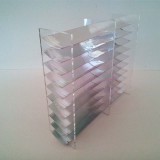The main theme of the Research is the conception of the natural light’s function, how it affects the living conditions in an enclosed space of a building, as well as the possibility of controlling solar radiation by incorporating shading system. Specifically, an extensive research is being shown about the features of the louvers’ performance, vertically placed to the outer side of the openings. However, emphasis is paid to the analysis of sunlight, taking into consideration three important factors shaping the way of exploitation of the sun in buildings (namely, the positions of the sun – light source, the optical properties of sun light and the characteristics of the architectural space that receives light).
The incorporation of shading and lighting systems in buildings, is based in human activity, aiming to improve the thermal and visual comfort, reduce the rate of direct and diffuse solar radiation entering the building, the proper distribution of brightness of the sun, the sky, buildings and
land, and finally, to give solutions to the energy consumption costs to meet human needs.
The basic parameters of selecting a shading system are:
1. the daylighting rate entering inside the building,
2. the distribution of daylightning,
3. the possible existence points to the bright space,
4. and the manufacturing and positioning cost.
The design of such systems significantly affects the architectural design of the building. The openings on the facades of buildings, orientation and internal location of rooms and their objects, will be given based on the system’s capabilities.
Naturally, when planning should be considered the availability of natural light, which is determined by the latitude of the location of the building and the environmental conditions (eg the presence of obstacles). Significantly affects the climate of the area. Thus, the recognition of seasonal and prevailing climatic conditions (ambient temperatures and chance of sunshine), are key criteria in the design of a system.
The shading and lightning systems can be an integral part of the building inside or outside of its facade, or in windows between the windowpanes. In any case, the solar radiation is prevented, wholly or partly. The exterior shading systems are considered to be effective to prevent the concentration of solar gains inside the building, and internal shading systems, using special coatings of reflective materials, can reflect sunlight while carrying some of the solar gain inside room.
Finally, the assessment of such systems is based on the calculation of solar radiation that enters the interior of the building, due to the reflect of the louvers’ system. The results achieved with the help of the computer program named tracepro.
Purpose of the Research
The purpose of the research is the study of the natural lightning (daylightning) and how it affects living conditions in an enclosed space along with the addition of shading systems embedded in building facades. For the optimization of the sunscreen systems’ operation, is being taken mainly the demanded consuming energy for heat and cool, providing thermal and visual comfort inside the building while maintaining the intensity of natural lighting at a satisfactory level during the winter and summer.
This particular sunscreen system consists of a parallel system of reflective louvers which are slightly curved. The louvers reflect the light (sunlight) in any direction we want, providing the main advantage of the absolute control of daylightning. Consequently, during summer solar rays are not allowed inside the building, whereas in winter solar rays are allowed inside the building. Therefore, the need for shading is wholly covered so as to avoid glare, while also it is being achieved an evenly distribution of natural light (daylightning) and the reduction of the energy cost.
